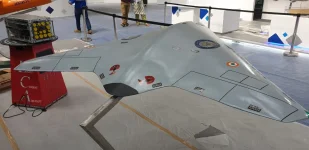- Views: 3K
- Replies: 19
Following a recent escalation in hostilities between India and Pakistan, remnants of a Chinese-manufactured PL-15 air-to-air missile have captured the focus of global intelligence agencies.
This missile, allegedly launched by Pakistan during an intense aerial confrontation with India in the preceding week, was found within India's Punjab state.
The Five Eyes intelligence-sharing network, which includes the United States, United Kingdom, Canada, Australia, and New Zealand, has, alongside France and Japan, shown significant interest in examining the recovered missile parts.
The incident, occurring amidst the heightened conflict between India and Pakistan, presents an uncommon chance to gain valuable information about a key piece of China's advanced military hardware.
Indian officials retrieved pieces of a PL-15 missile on May 9, 2025, from a field in Hoshiarpur, Punjab, after severe aerial confrontations with Pakistan. These clashes followed a terrorist incident in Pahalgam, Kashmir, on April 22, 2025, which resulted in 26 civilian deaths and prompted India's retaliatory "Operation Sindoor."
This operation aimed at suspected terrorist facilities in Pakistan, leading to a quick counter-action by the Pakistan Air Force (PAF). In these engagements, Pakistan reportedly utilised its Chinese-provided J-10C and JF-17 fighter jets equipped with PL-15E missiles, signifying the first verified combat deployment of this sophisticated weaponry.
Developed by the Aviation Industry Corporation of China (AVIC), the PL-15 is an advanced long-range air-to-air missile designed for engagements beyond visual sight. It features a sophisticated active electronically scanned array (AESA) radar for guidance and a dual-pulse rocket motor for extended reach and energy.
While the version used by China's own forces is stated to have a range of 200 to 300 kilometres, the PL-15E export model, employed by Pakistan, has a more limited range of about 145 kilometres.
Its advanced guidance capabilities and high speeds, reportedly between Mach 4 and Mach 5, position it as a significant threat capable of engaging crucial targets such as enemy fighter jets and airborne early warning aircraft.
According to Indian authorities, the PL-15 missile did not reach its intended target. It was reportedly either neutralised by India's air defence measures or experienced a malfunction, leading to its debris falling in Punjab.
The recovery of these remnants, which some accounts suggest are "largely intact," has generated considerable international attention because of the missile's advanced technology and the potential consequences for security in the region and worldwide.
Global Interest in Recovered Missile Technology
Several nations and intelligence alliances are eager to study the downed missile for multiple strategic reasons:- Technological Insights into Chinese Military Advancements: The PL-15 missile is a critical component of China's aerial warfare strategy and is built to compete with leading Western missiles, such as the American AIM-120D AMRAAM and Europe's MBDA Meteor. Its advanced features, including an AESA radar seeker, a two-way datalink for communication, and a dual-pulse motor, exemplify state-of-the-art military technology. Examination of the recovered missile could uncover crucial information about its guidance mechanisms, propulsion system, and how it resists electronic jamming. This offers an infrequent opportunity to understand China's military manufacturing capabilities. For the Five Eyes nations, especially the United States, this information is vital for developing strategies to address potential threats from China, particularly in the strategically important Indo-Pacific area.
- Developing Countermeasures: Access to even fragments of the PL-15 could allow intelligence services to identify its weaknesses. For example, studying the missile's seeker head might lead to the creation of electronic warfare techniques designed to disrupt or mislead its radar system. This is highly significant for France, as its Rafale fighter jets, armed with Meteor missiles, were reportedly among the targets of PL-15s in the recent conflict. Japan, which uses F-35 aircraft and is working on its own missile technologies, is also keen to strengthen its defence capabilities against Chinese military hardware.
- Geopolitical Significance: The first confirmed combat use of the PL-15 highlights China's increasing importance as an arms provider to Pakistan, one of its close allies. The Five Eyes alliance and Japan perceive China's growing sway in South Asia as a strategic concern, especially concerning the security dynamics of the Indo-Pacific region. France, being a significant supplier of military equipment to India, is interested in making sure its Rafale aircraft maintain a competitive edge against aircraft armed with Chinese technology. A detailed analysis of the PL-15 could influence future defence agreements and military partnerships with India.
- Learning from Past Incidents: Historically, obtaining advanced foreign weaponry has provided significant advantages to intelligence organisations. A well-known example is the incident in 2011 when a U.S. Black Hawk helicopter crashed in Pakistan, and it was reported that Chinese engineers were given access to the remains. If India decides to share information from the PL-15 with its allies, it could be seen as a significant turn of events, potentially reinforcing intelligence cooperation agreements with the United States, France, and Japan.
Indian statements have highlighted the effectiveness of their air defence systems in stopping the missile, which might mean the recovered parts are damaged or not fully intact.
Furthermore, India's decision on sharing this sensitive information with allied nations will likely be influenced by diplomatic and strategic factors, particularly considering its careful navigation of relationships with Western countries and Russia.


